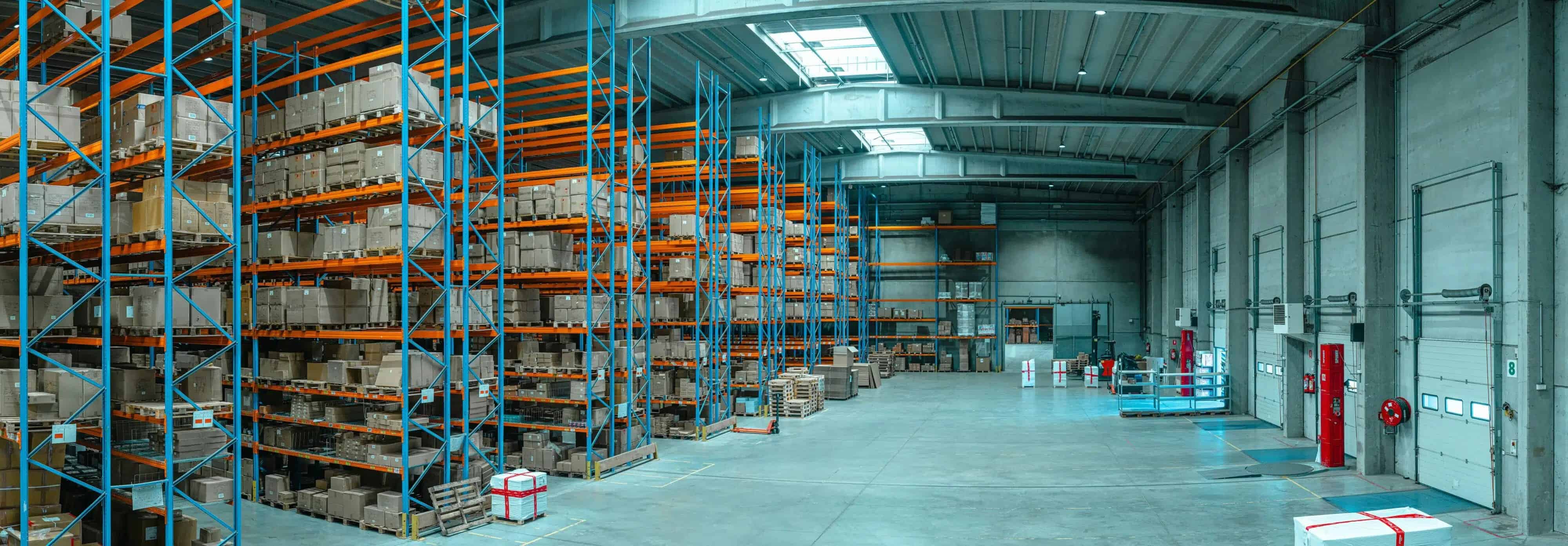Rack protection is paramount for warehouse safety, whether in a warehouse, distribution centre, or factory with substantial storage needs. Without any racking protection, you run the risk of damaged racking, which increases health and safety risks and incurs maintenance and repair costs.
CT Safety Barriers provide durable warehouse protection products crafted for your warehouse in a compliant, cost-effective manner.
What are racking protection barriers – and why do you need them?
Warehouse racking – or pallet racking – is a system of shelves, racks, and storage structures for holding goods safely. They often rise up to 4 metres high and can store very heavy objects. This makes protecting them vital as if they become damaged or knocked over, it could cause serious injury – or worse.
Warehouse racking protection barriers are used to absorb the impact from forklifts and other vehicles, extending the lifespan of your racking and reducing accidents.
This form of site protection is important for:
- Improving general safety: Rack protectors play a crucial role in ensuring the working environment is safe, reducing the risk of accidents and injuries.
- Creating robust storage: Rack protectors help keep goods stored neatly and well on the racks, ensuring they don’t fall or move from where they are placed.
- Damage prevention: Rack protectors prevent damage to existing racking structures, absorbing and deflecting impacts to avoid excessive costs.
- Providing cost savings: By protecting goods and structures, you save costs incurred by potential damages.
- Safety Compliance: Rack protectors help keep your worksite or warehouse compliant with current warehouse safety regulations.
Where you need racking barriers
Racking protection is needed in several locations across the warehouse, including:
- High traffic areas
- Heavily stocked storage areas
- Working zones
- Aisle ends
- Cross-aisles
- Loading/unloading zones
- Narrow corridors or turning points
- Other vulnerable areas
The HSE advises pallet racking and other safety accessories should be placed in areas where racking is likely to be struck by lift trucks and other vehicles.
Safety regulations for warehouses and pallet racking barriers
Racking safety is a vital part of your efforts to provide adequate regulation-grade safety measures in your workplace. They must provide:
- Protection: Rack protectors must ensure that workers are protected from stored goods.
- Visibility: Racking must be highly visible to forklift drivers, workers, and pedestrians.
- Correct usage: Misuse of racking is prohibited by compliance standards. This includes climbing and overloading.
- Accurate placement: The HSE stipulates that racking be placed on sound, level floors that can withstand the loading point at each base.
- Compliance protection: Warehouse conditions must be protected against safety audits and compliance reports.
- Safety training: Safety training is key to ensuring your racking complies with regulatory requirements.
Types of racking protection
CT Safety Barriers manufacture and install various types of warehouse racking protection devices that can provide the thorough and robust protection that your warehouse needs to be HSE compliant, including:
- Rack protector: These protect the base of racking systems from forklift and pallet jack damage.
- Guardrails: These products separate pedestrians from vehicles while protecting walkways and heavy machinery.
- Barriers: Safety barriers provide all-purpose obstacles to prevent access to areas, guide traffic, protecting your workforce, pedestrians, and stored assets.
- Rail protectors: These protectors shield guardrails and edges from impacts, extending the life of your safety infrastructure.
Racking barrier installation process
Rack protection barriers are generally very easy to install, especially if you’re working with high-quality, pre-fabricated products. They are usually surface-mounted, meaning they’re bolted directly into the concrete floor using anchor bolts.
Racking barriers are often supplied with pre-drilled holes and fixings included, allowing you to install them within just a few minutes provided the floor is prepped. Your installation process will look something like this:
- Survey the warehouse: Locate and isolate the most vulnerable areas in your warehouse.
- List vulnerable areas: Make detailed records of where to place the safety measures, for reference later.
- Find the best rack protectors: Decide which rack protection devices to implement. Pick a reputable vendor of safety barriers, potentially one who will also install them.
- Clear the area and install: Ensure the area is cordoned off before work begins, ensuring a smooth process with minimal operational disruption.
- Carry out Inspections & maintenance: Rack protectors should be inspected and maintained regularly to ensure they meet standards and remain robust for the long-term.
If you’re doing it yourself
If you’re installing your rack protection barriers yourself, you will need the following:
- A drill and masonry bit
- Bolts and anchors (supplied)
- Spanner or impact driver
- Spirit level to ensure alignment
Mark your positions carefully, ensuring they don’t restrict pallet access. If it’s a big project, install them during downtime or off-hours. For maximum stability, you should make sure the concrete slab is in good condition – no cracking or crumbling where you bolt them down.
Safety-proof your warehouse with CT Safety’s Racking Barriers
Installing rack protectors is fundamental if you have a substantial amount of goods and supplies to safeguard, or assets stored in areas with high pedestrian and worker traffic.
At CT Safety Barriers, our pallet racking safety barriers are installed and manufactured by our expert team with durability and flexibility in mind, so they suit a dynamic range of environments. We can provide solid advice on your safeguarding needs.
If you need to discuss a project, get in touch with us. We are eager experts who are happy to assist you in your projects.
Call us on (01977) 666 818
Alternatively, email us at sales@ctsafetybarriers.co.uk

